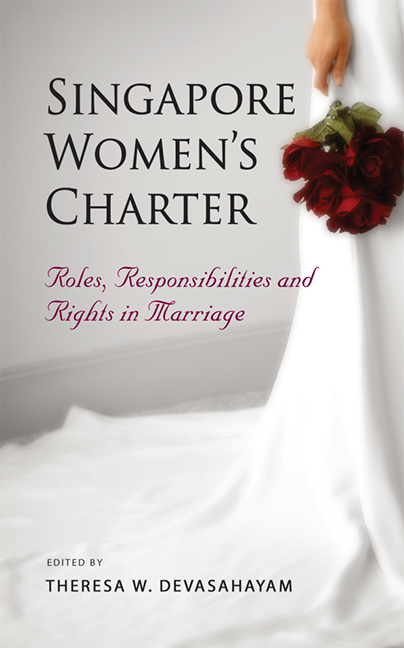Book contents
- Frontmatter
- Contents
- Contributors
- Foreword
- Keynote Address
- 1 Legal Mechanisms for Protecting Women's Rights: Examples from Southeast Asia
- 2 The Women's Charter, 1961: Where We Were Coming From and How We Got There
- 3 Significant Provisions in the Women's Charter
- 4 A Lawyer's Perspective on How Divorcees View the Women's Charter
- 5 “The Morning After”: Understanding and Exploring the Psychosocial Impact of the Women's Charter on Families Experiencing Domestic Violence
- 6 Epilogue: Some Thoughts on Protecting Women's Rights in the Family and Beyond
- Index
Foreword
Published online by Cambridge University Press: 21 October 2015
- Frontmatter
- Contents
- Contributors
- Foreword
- Keynote Address
- 1 Legal Mechanisms for Protecting Women's Rights: Examples from Southeast Asia
- 2 The Women's Charter, 1961: Where We Were Coming From and How We Got There
- 3 Significant Provisions in the Women's Charter
- 4 A Lawyer's Perspective on How Divorcees View the Women's Charter
- 5 “The Morning After”: Understanding and Exploring the Psychosocial Impact of the Women's Charter on Families Experiencing Domestic Violence
- 6 Epilogue: Some Thoughts on Protecting Women's Rights in the Family and Beyond
- Index
Summary
I thank the Director of the Institute of Southeast Asian Studies (ISEAS), Ambassador K. Kesavapany, for inviting me to contribute the Foreword to this volume which contains the papers submitted to the symposium “Revisiting the Singapore Women's Charter”. The symposium was organized by Dr Theresa W. Devasahayam, the coordinator of the gender studies programme at ISEAS.
First, I am very pleased that ISEAS has a programme on gender policies and issues in Southeast Asia. I consider the emancipation of women and the recognition that women are entitled to equal rights with men as one of the greatest achievements of the twentieth century. The UN Convention on the Elimination of All Forms of Discrimination Against Women (CEDAW), of which Singapore is a party, is one of the most important treaties in public international law. It seeks to put an end to a shameful period in human history, lasting thousands of years, during which women were treated as chattels and having no rights or as inferior human beings and discriminated against in a myriad of ways. It is, of course, true that CEDAW has not been fully implemented by all the state parties or by all the member states of the UN. However, those who invoke culture or religion to justify discrimination against women know that theirs is a losing battle. They are on the wrong side of history. I am convinced that one day, in this century, the dream that women will enjoy the same rights as men will come true for all womenkind.
Second, in Singapore the enactment of the Women's Charter in 1961 was a revolutionary act. It put an end to polygamy for all Singaporeans, except for Muslims. Section 46 of the Charter, inter alia, gives the wife the right to use her surname and name; to have equal rights with her husband in running the matrimonial household; and the right to engage in any trade or profession or social activities. Compared to the situation prior to 1961, these were transformative propositions.
- Type
- Chapter
- Information
- Singapore Women's CharterRoles, Responsibilities and Rights in Marriage, pp. ix - xiiPublisher: ISEAS–Yusof Ishak InstitutePrint publication year: 2011

